
Mite treatment in human and Veterinary Medicine
Mite treatment in human and Veterinary Medicine
Dr. rer. nat. Denis Pfister-Grune, Naturopath/Biologist, Braunsbedra OT RoBbach, Germany
1 Introduction
1.1 Choice of topic
When | was asked if | could give a presentation at our big congress, | quickly realized which topic | would choose. Together with my wife and our three children, we run an organic beekeeping business. With currently 40 bee colonies, there is a lot to do. | have been working as a naturopath in our practices in RoRbach and Halle (Saale) for almost 10 years. Here we mainly treat allergic diseases, whereby the BICOM® bioresonance method has been the most important therapeutic pillar from the very beginning. In addition to this, beehive air therapy was added a few years ago. In the months of May to August, it is a further instrument for alleviating allergic respiratory diseases. Again, | am supported in this by my family, as there is an apistation at both practice locations where inhalation therapy is carried out.
As most of you know, bee colonies have been threatened by’the varroa mite, which is widespread worldwide, for several decades. It is considered to be one of the main causes of bee mortality in Germany in the autumn and winter, especially in combination with exposure to insecticides. All beekeepers have to deal with this type of mite sooner or later, and efforts are being made worldwide to find suitable methods or measures to combat the mite or to make bees more resistant.
So, | quickly found my topic. In the wider context of mite treatment in human and veterinary medicine, | would here like to give you an insight into our project: to make bees more resistant to the varroa mite. Chapter 5.4: Treatment of the varroa mite with the BICOM® bioresonance method presents our small research project, which we started in the autumn of 2023.
My contribution is aimed at therapists who are interested in the bioresonance method or who are beginning to delve deeper into the treatment options with the BICOM® device. Allergies and intolerances have been a focus of the bioresonance method from the very beginning. Diseases associated with mites – above all house dust mite allergies – are of course part of this.
In order to maintain an overview within the very large topic of mites, | will limit myself to the most important agents and diseases of humans and animals that | have found in my research (RTI booklets and specialist literature) to date, and add my own experiences. In doing so, | will remain within a narrow framework and exclude, for example, diseases transmitted by ticks. There have already been several articles and publications on this topic in past congresses on the bioresonance method.
2 The world of mites
Mite treatment in human and veterinary medicine – it’s easy to think: “That’s a very general topic and we treat it on the side”… Yes, it’s true! It is a general topic, as mites, which are arachnids, are omnipresent, i.e. present everywhere in our biological systems. They are as old as they are diverse. Fossil evidence dates back over 230 million years, so that today around 50,000 different species have been described worldwide. The size of individuals varies from about 0.1 millimeters
to the largest – the ticks – where the females can reach a size of 3 cm. Mites have “eight legs and a rather poor sense of sight – some mite species even have no eyes at all and rely solely on their well-developed sense of touch” (Geo.De 2024).
A distinction is made between groups:
1. Predators and scavengers: many Gamasids (red bird mite) and Actinedids
2. Herbivores: plant suckers (e.g. gall mites), many Acaridida as storage pests (e.g.
flour mites) and fungus eaters
3. Detritus eaters: Oribatida (horn mites) in the soil
4. Paraphages: eat bodily waste products such as dander, e.g. feather mites
5. Parasites: particularly many different groups: Ectoparasites feed on blood, lymph, cells and fluid tissue (e.g. Varroa destructor); endoparasites: penetrate the skin from the outside (e.g. scabies mites).
(Source: Geo.DE 2024)
Around half of all mite species live in the soil — with up to 100,000 animals per square meter under optimal conditions. Despite the fact that they make a significant contribution to humus formation here, some of these species are regarded as major agricultural pests.
Due to their diversity, mites can be found in almost all habitats. Many non-predatory mite species “went hand in hand with the development of angiosperms, and the radiation of birds and mammals offered great opportunities for specialization for epizoic and parasitic mites” (SPexTRUM 2024).
Thus, they have always been part of the human environment and, depending on the mite species, neither humans, animals nor the environment are spared. For this reason alone, it is necessary to narrow things down. | will therefore limit myself below to the mite species that are the most important disease-causing or disease-transmitting mites in humans and animals.
2.1 Diseases associated with mites (a selection)
Mites (Acari) are a subclass and the largest group of arachnids (Arachnida) in terms of species. As

parasites, they infest humans and animals, sometimes without them noticing. A disease caused by mites is known as acariosis. Are mites always the cause of the diseases? No, they are often a vector, i.e. an
organism that transports a pathogen (e.g. viruses and bacteria) from one host organism to another. This means that mites not only act as triggers, but also as carriers of a disease.
DR. SABINE RAUCH writes: “Many viruses are transmitted by an intermediate host or vector (e.g. mosquitoes, arachnids): Mosquitoes, arachnids such as mites or ticks or also by fungi)” ( RaucH 2021:2).
2.1.1 Main agents in human medicine
The following table provides a selection of the diseases that dominate human medicine in Central Europe and are directly or indirectly associated with mites. It does not claim to be exhaustive.
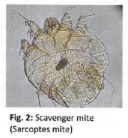
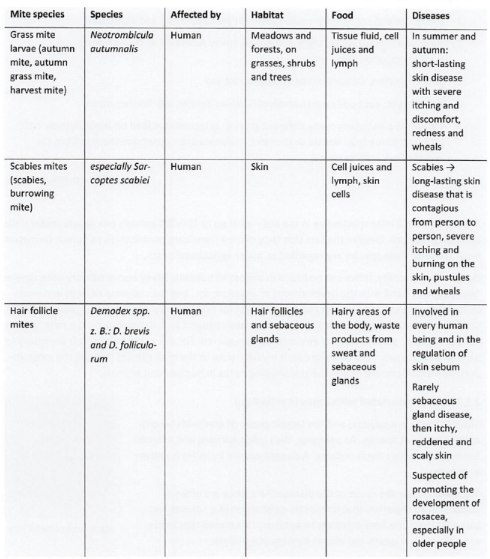
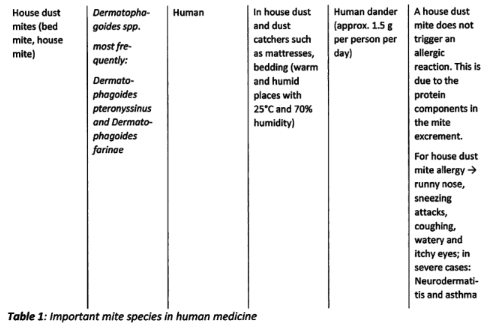
The most prominent mites in humans are house dust mites. According to the Allergy Information Service, Wieshaden-based scientists estimate that “in Germany, around seven percent of the population suffers from a year-round house dust mite allergy. In the USA, this figure is said to be around 20 million people” (ALLERGIEINFORMATIONSDIENST 2024). In comparison: … “Hay fever is the most common allergic disease. In Germany, 15 percent of adults are affected” ).
One reason for the frequency of laboratory-diagnosed, mite-specific antibodies is the everyday presence of allergens in early childhood. Mite feces are the second most common cause of allergies after pollen. When the mite excrement dries, it breaks down into small dust particles, which then sail through the air. If we inhale the particles, an allergic reaction can occur, as just one gram of house dust can contain more than 250,000 of these fecal pellets (see ALLESUEBERMILBEN.DE).
There are numerous combinations, which means that house dust is not always the main allergen. In fact, mites are usually an “accompanying burden”, for example together with molds. In his book Biophysical Diagnosis and Therapy of Allergy, published in 2012, DR. PETER SCHUHMACHER explained that the proportion of “relevant house dust mite allergies” in his practice was surprisingly low (see SCHUHMACHER 2012: 153). He attributed this to the fundamentally different test methods -immunological detection of specific antibodies versus biophysical tests at the information level. Both test methods were “not necessarily synonymous with an allergy that actually bothered the patient in any way”, so he advised his fellow therapists elsewhere: “First of all, doubt every positive house dust mite test that the patient tells you (prick test, RasT, etc.) and rely on your own test result” (SCHUHMACHER 2013: 76).
The association of house dust mites with mold fungi, for example, has been described at past congresses by some speakers who work with the BICOM® bioresonance method. Bettina Decher spoke of a symbiosis between the two species: “Some mold species live unnoticed in house dust and form a symbiosis with house dust mites. Aspergillus repens, for example, lives on human skin flakes and prepares them as food for a species of house dust mite (syn. skin mite, Dermatophagoides sp.). The fungi themselves are also consumed by the mites. Fungi have been found in the digestive tract of mites. From there they enter the mite excrement, which contains the potent mite allergens. Therefore, every house dust mite allergy should be considered and checked for mold contamination” (pEcHER 2013: 43).
The composition of allergens is always different from place to place – in the living room or in hay, in the sebaceous glands of the skin or in the beehive. Yet everywhere there are mites to think about – this is life. As early as 1992, DR. MED. DENT. G. CORNELISSEN posed the logical question: “Is there an allergy to house dust mites at all or are the mites and house dust only allergy carriers?”
(CORNELISSEN 1992: 38). It is reasonable to assume that this is the case in many cases. He therefore recommended that molds should be tested and treated if a house dust mite allergy is reported (ibid.).
In successful BICOM® treatment, we always ensure that patients are well prepared by treating blockages and supporting the elimination organs. Depending on the bioenergetic test result, this is followed by the treatment of chronic masked allergens (milk, wheat) and the indication-related follow-up treatments (see section 3.1).
Allergies – especially house dust mite allergies – very often develop in childhood and adolescence and last a lifetime. If there is no adequate treatment, and a so-called “stage change” can occur over the years. This means that the symptoms move from the upper to the lower airways and can ultimately lead to bronchial asthma. Among the inhaled allergens, “mite” and “house dust mite” ampules have a firm place (see section 3.1.1). This is because exposure to house dust mites is a multi-causal factor not only in allergic reactions of the nasal cavities (see wenzeL 2012: 98 ff.), but also in neurological diseases (see WAGNER 2012: 144) and is therefore figuratively a “large load in a barrel”.
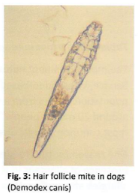
2.1.2 Main agents in veterinary medicine
The following table shows a selection of mite species that are responsible for the development of various diseases in animals. The sources for Tables 1 and 2 can be found in Section 7.2.
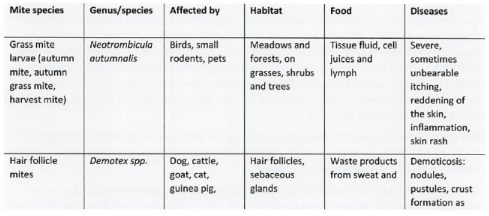
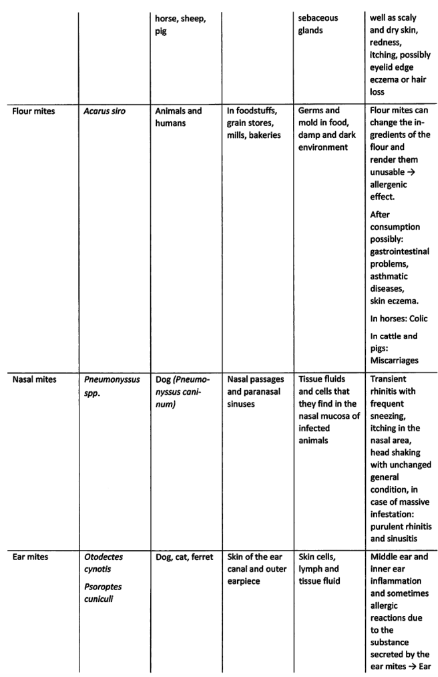
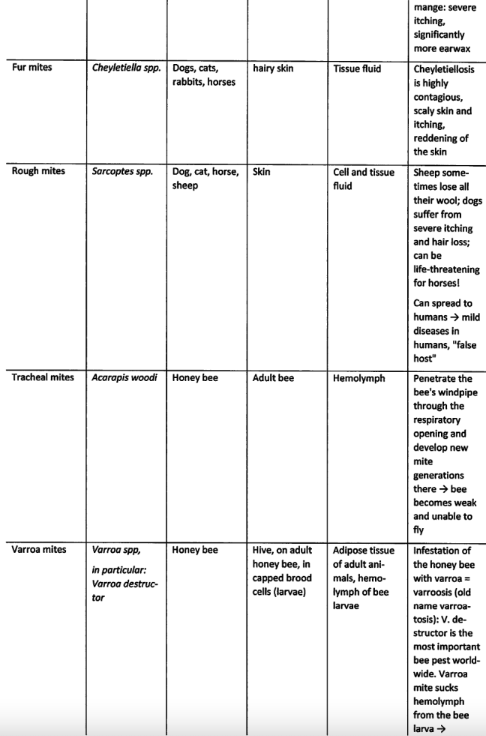
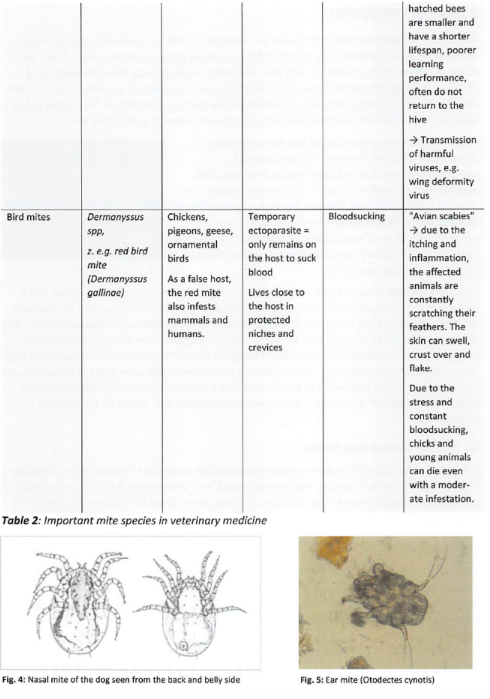
3 Treatment approaches
The treatment options of scientific human and veterinary medicine to combat mites themselves or the diseases caused and/or transmitted by them cannot be discussed in this article. There are extensive references in the literature in print and online media to drug-based attenuation of allergic events, allergen immunotherapy including hyposensitization (cf. wiLDF6RsTER 2023: 82 ff.)
and the use of acaricides (pesticides or biocides) to control mite populations. The author of this paper is not in a position to assess how successful these treatment approaches are.
This is in no way intended to imply that the possibilities of so-called conventional medicine can be replaced by complementary medical and naturopathic therapies. Each approach has its justification and in some cases achieves outstanding results in its field. The goal for the future must be to combine the possibilities and experience of conventional medicine with those of naturopathy/complementary medicine even more. Our BICOM® bioresonance method can make an
important contribution to this. Fig. 6: House dust mite
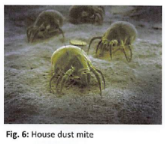
As a therapist with almost 10 years of experience in the BICOM® bioresonance method, and a biologist and naturopath myself, | want to deal here with the diversity of the topic of mites with the aim of discussing the basics and passing on tried and tested methods to new generations. For this reason – and in accordance with an “International Congress on the Bioresonance Method” – I will deal exclusively with the possibilities of using the BICOM® bioresonance method in the fight against mites and their diseases. It should also be mentioned at this point that the following is not intended to be a rigid framework of recommendations. Rather, it is based on over 35 years of experience of BICOM® therapists, manuals, recommendations and, above all, my personal experience.
3.1 BICOM® bioresonance method
It is part of the practice of medicine to take a detailed and meticulous medical history, including examinations. Existing laboratory tests can be helpful. And this is where the paths and opinions of practitioners diverge. Should | have the allergy results shown to me or not? | ask my patients to bring everything they think is important to the initial anamnesis because | am always in favor of a diagnosis with all points of view. The therapeutic steps of my treatment must be decided on an
individual basis.
As already mentioned in 2.1.1, the therapy recommendations of our BICOM® bioresonance method for “chronic patients”, i.e. people who have been suffering from stressful allergic symptoms for a long time, are arranged in a step-by-step protocol. This is used, for example, in the treatment of house dust mite allergies or recurring illnesses triggered by mites.
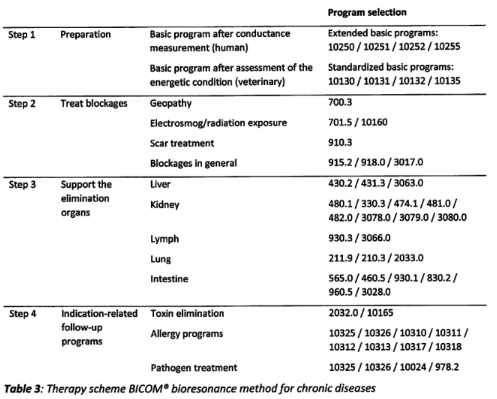
The choice of therapy programs is determined by bioenergetic testing – in our practice this is primarily tensor testing. In addition to the tensor and the kinesiological muscle test, we also have the option of using the BodyBalanceCheck (BBC) for human medicine. A large number of indications in the patient’s energy body can be analysed in this way. Of course, this also includes stresses such as house dust or mites.
Safe handling of the tensor is not only important from step 4 (selection of indication-related therapies). However, it is precisely in this phase of treatment that the available ampules from the test kits (see section 3.1.1) or the body’s own secretions/excretions are used, which play a key role in the treatment of mite diseases. The tensor is an important tool for targeted differential diagnosis. The BICOM® devices offer various test programs. These are the programs for incriminating substances:
170.0 Test Ai8 x amplification / all frequencies
191.0 CTT Test Ai with F-SW
197.0 CTT Test Ai with F-SW and A-SW
For the successful treatment of long-term illnesses, it is always necessary to focus on the so-called “chronic masked allergens” such as milk and wheat protein. These “big chunks in the barrel”, i.e. the allergic stress from them, can very often be detected bioenergetically or even chemically in laboratory tests in humans and animals. If this is the case, it is highly advisable to treat them in advance. After steps 1 to 3 (see Table 3), the treatment of milk and/or wheat would be the first treatment priorities in step 4. The program sequences 10325 (pathogens Ai) or 10313 (allergy, chronic, masked) with the corresponding ampules (milk, wheat) and/or the native materials from the patient’s food/environment (purchased flours, dairy products, etc.) are suitable as therapy programs.
In addition to the treatment of chronic or recurring diseases associated with mites or their products, it is of course also possible to achieve treatment success for acute conditions. This can be used, for example, in the case of an acute infestation of autumn or ear mites. The following overview shows one way of doing this:
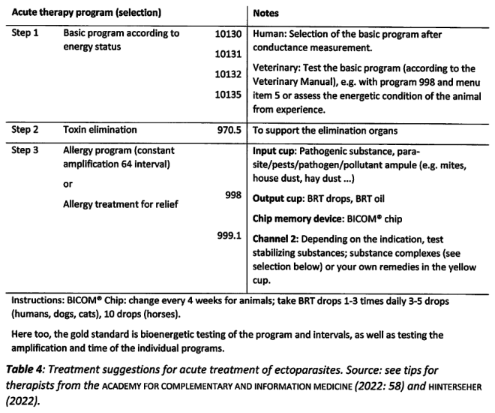
3.1.1 Proposals for indication-related treatment of mite diseases (in chronically ill humans /sick animals)
In the extended treatment concept of a chronic or recurring disease, step 4 is the start of the actual treatment with the allergens, as shown in Table 3. It takes place after steps 1to 3 (blockages, detoxification, allergy preparation …) have been carried out on the patient in several therapy sessions and any existing exposure to milk and wheat protein has been treated. This means that “big chunks have been taken out of the barrel” and the (energy) body of humans and animals is now well prepared for the treatment of chronic stress.
In the lecture topic, the main allergens to be treated are mite information or material from the direct environment of the disease. However, the therapy process can generally be applied to the treatment of allergies or pathogens using the BICOM® bioresonance method.
Therapy programs with treatment types Ai and Di are particularly suitable, but theoretically also H+Di programs. It is advisable to test these types of treatment bicenergetically in advance. The following programs and program sequences, among others, have proven successful:
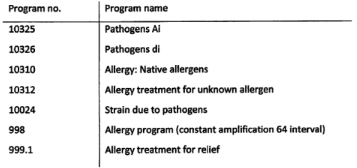
The input cup contains the pathogenic substance to be treated or the parasite/parasite. Various ampules are available for this purpose. The following two overviews show a selection from REGUMED GmbH for both human and veterinary medicine:
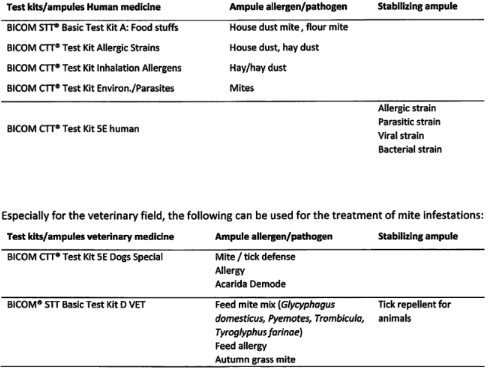
Ampules are available in the test kits mentioned for the testing or treatment of highly probable combinations with mite contamination (see 2.1.1) such as molds, duck and goose feathers, milk or wheat protein. In addition, a corresponding number of other test kits are available. These include the BICOM CTT® Test Kit Viruses, Fungi, the BICOM CTT® Test Kit Immunology/ Haematology and the BICOM® STT Basic Test Kit B: Allergens and strains.
Testing this complicates the diagnosis, but is often the guarantee for success. This is because asthma patients not only test for house dust and mites as primary or “year-round allergens”, but also for a wide variety of allergy triggers, such as apples, milk, molds or the grass mix (see JunG and JIN 2006: 51 ff.).
The same applies to veterinary medicine, where it is often the case that in skin problems with dogs (dandruff, itching) mites can be associated with skin fungi (cf. HARTE 2009: 100 f.), and often “the mite ampule only tests together with the milk ampule” (MULLER 2011: 66) or there are reactions to mites together with house dust mites and food mites (cf. ENGEHAUSEN 2022: 56). With this multitude of conceivable possibilities, dogs can be treated, for example, with a combination of
soy-wheat-yeast-Candida-Aspergillus mites (cf. SIORBERG 2022: 25).
There can therefore only be one recommendation: Please test individual stresses carefully for each person or animal!
If the appropriate test ampules are not available, samples from the diseased organism and from the immediate environment provide the right starting point. There are no limits to the imagination here, as long as the basic principle is observed: we present the BICOM® device with as much antigen information as possible and as specifically as possible.
These can be samples from the vacuum cleaner or a tissue full of nasal secretions in the case of house dust mite allergy, as well as a dust sample on an adhesive strip hung up in the office and at home (cf. kasasi 1996: 36). It is important to advise patients to “have a dust sample checked quarterly, as the mite larvae change and reactions can occur again” (JANSEN 1996: 36). This has the
advantage – similar to a pollinosis therapy carried out over several years – that an extensive allergen pool is introduced to the immune system over a manageable period of time and can be treated. This is confirmed by the experience of DR. MED. JURGEN HENNECKE, who also refers to the combination with mold fungi in the following quote (HENNECKE 1996: 84 and in: HENNECKE and Maquinay- HENNECKE 2023: 122).
“Allergies to house dust mites are most likely to lead to respiratory symptoms, but can also worsen the skin condition of neurodermatitis sufferers. We always use our own original house dust (flakes from the vacuum cleaner) in addition to the house dust mite ampule. This certainly contains some additional information (fabric fibers, animal hair, dandruff, mold). In some patients, it was noticed that after a house dust allergy had been treated, the house dust obtained at a different time of year reacted again. In my opinion, seasonally growing molds play a role here and persistent patients should be retested from time to time.”
Depending on the clinical picture and symptoms, suitable endogenous substances are, for example, skin flakes, sebum of the scalp (hair follicle mites), secretions from raised pustules and wheals (scabies mites) in people with infested skin areas. If we look at animals infested with mites, wool and hair (mange mites), nasal secretions in the case of rhinitis and sinusitis (nasal mites) or easily detachable scabs, crusts or secretions from the ear (ear mange) are conceivable additional
materials for targeted treatment. At this point, | would like to point out that when using the body’s own components, the treatment types Di and H+Di should be tested instead of an “Ai mode”.
These endogenous secretions and excretions can also be an effective support for relief with the appropriate potentiation program in the form of BRT drops or BRT oils.
Once the appropriate stress ampules for the mite disease have been found and – this would be the gold standard – supplemented with body-specific or pathological materials or the room environment, we have the option of using our own remedies (yellow cup) or substance complexes with channel 2.
Stablizing remedies can be used for support, depending on your own experience and professional orientation. If appropriate test kits are available, the stabilizing ampules in the two overviews just presented are also included.
In our practice, the following can be used to treat allergies: hay fever spray (Weleda), Calcium Quercus Globuli velati (Wala), Gencydo 0.1 % eye drops (Wala) and Acidum formicidum D6.
However, Fenstil drops, Cetirizine drops, Salbutamol, Atrovent or Viani forte are also included in the selection. The most effective results are achieved with remedies that work on the information level. The more material it is, the less effective it is.
One substance complex related to the topic of the lecture is Allergy House Dust. In addition, and depending on the severity of the symptoms, the following can also be used (selection): Alternaria (mold, cereals); Asthma; Atopic dermatitis; Eczema allergic; Conjunctivitis allergic; Pollinosis (hay fever); Propolis; Sulfur D30; TCM Asthma; TRB Allergy pollen, food, animal hair and Viral immunodeficiency. Bioenergetic testing of the appropriate substance complexes is also recom-
mended here.
Therapy step 4 described in this section (see Table 3) shows the complexity of mite therapy, which also aims to provide individualized treatment targeted at the pathogen and the combinations.
The “indication-related follow-up programs” are repeated as required (tensor test to determine whether programs are still needed). In our practice, we aim for a weekly interval with up to three repetitions. If the treatment days are further apart, we give the patient BRT drops, BRT oils or BICOM® chips.
It is possible to treat individually or in combination, i.e. several ampules of harmful substances at the same time. It is advisable to always check this with biophysical testing. In this way, the combinations of mites or house dust described above can be treated individually and effectively.
4 Study situation
Studies based purely on mite treatment with the BICOM® bioresonance method with a scientific claim are very rare. The available literature includes one in-vitro study on house dust mite allergy (see RAHADIAN 2019). The aim of the study was to “evaluate the influence of bioresonance electromagnetic waves on the changes in pro-inflammatory messenger profiles (interleukin 4 and 13) and the anti-inflammatory messenger (interleukin 10) produced by whole blood cell cultures” (ibid.:124). The test subjects suffered from a rhinitis allergy triggered by house dust mites (type 1 hypersensitivity, acute allergy reactions).
It was shown that the BICOM® bioresonance method reduced the production of the proinflammatory interleukins 4 and 13 and, in turn, increased the anti-inflammatory interleukin 10 (ibid.: 126).
The new approval study for the BICOM® optima also had, as an inclusion criteria, adults and children aged 4 years and older with symptomatic allergic rhino-conjunctivitis (triggered by house dust, pollen and animal hair). Patients with these symptoms were examined in 8 practices for approximately one year, whereby 111 patient histories could be used for evaluation. The treatment was to comprise a maximum of 8 allergy therapies within 15 weeks. The results showed a significant improvement in the symptoms and quality of life of the patients and thus the effectiveness of the BICOM® bioresonance method for this condition (see ReGUMED GmsH 2022).
5 Mites as parasites of the honey bee
In order to make a contribution to this and to expand on knowledge in the treatment of mites, | aim to conduct a one-year study on the treatment of the Varroa mite using the BICOM® bioresonance method. As mentioned in the introduction, this mite is a very important species in the bee industry, and great efforts have been made worldwide for decades to combat it, but so far only modest successes have
been achieved.

5.1 Varroa destructor – The destructive mite
Varroa destructor was already known long before its description by ANDERSON & TRUEMAN in 2000 and was previously assigned to a different species that lived in Asia. The original host of V. destructor is the eastern honey bee Apis cerana, where the male bees – the P ” ” drones – in particular are infested (see ROSENKRANZ et. al 2010). The varroa mite was spread worldwide from Southeast Asia, e.g. by shipping bees or queens, so that it was also detected in Germany at the end of the 1970s The mite species, which is just under two millimetres in size found a new host, our western honey bee Apis mellifera (UNNAEUS 1758). As a result, the Varroa mite spread around the world. With the exception of Antarctica, all continents are colonized by it, and enormous efforts are being made to minimize bee mortality, which is largely caused by it.
5.2 Beauty and the beast
Varroa mites and honey bees do not represent a balanced parasite-host relationship in our latitudes (unlike in East Asia). For the bees here, the mites are a pure parasite infestation. Their astonishing life cycle, which has been the subject of worldwide research over the past few decades and has resulted in many control options having reached their limits, is shown in Figure 8.
During the 21-day development of the worker bee (and the three days longer development of the drones), the mated mother mite hatches into the brood comb, into the bee larva, shortly before the so-called “capping” and hides there from the nurse bees. At this stage, the larva, which develops into a mature insect, is helplessly exposed to the mite. The mother mite stings the bee larva to feed her offspring, first laying a male mite and then up to three daughter mites (up to four female offspring in the case of drone brood).
The male mite mates with the daughter mites until the bee hatches, so that after 21 or 24 days they are released fully developed into the colony. The male mite dies and remains behind (cf. DONZE et. al 1998). The infested bee is weakened because its development has been disrupted by the hemolymph-sucking mites. However, it is not only the Varroa mite itself that harms honey bees (it sits firmly on adult bees and feeds on the body of the animals until it hatches back into a brood comb), but the viruses it transmits also contribute negatively (vector function).
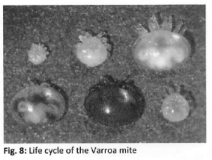
According to current knowledge, these include the deformed wing virus, the acute paralysis virus, the slow paralysis virus (SPV), the kashmir bee virus (KBV) and the cloudy wing virus (CWV) (see BIENENINSTITUT KIRCHHAIN, Virosen der Bienen
2024).
The deformed wing virus is widespread in our country (if the bee colony is heavily infested, numerous bees with crippled wings can be seen) and increasingly also the acute paralysis virus.
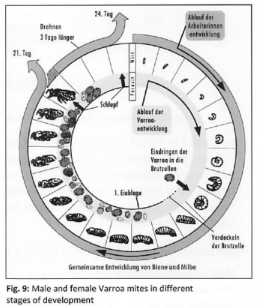
5.3 Conventional treatment options for varroosis
The term varroosis (old name: varroatosis) refers to the infestation or disease of bee colonies by the Varroa mite. Statements such as “successful beekeeping in Germany is not possible without treating the colonies against the Varroa mite” (BIENENINSTITUT KIRCHHAIN, Grund- konzept Varroabehandlung 2024) or varroosis “is currently the greatest threat to beekeeping worldwide” (BOECKING 2002 from the BIENENINSTITUT CELLE) show the urgent need to find suitable treatment measures so that bee colonies can withstand the mite burden. As a result, treatment concepts against Varroa infestation are now approved in conventional beekeeping – even for organic beekeeping – which include the use of organic varroacides (organic acids that also occur in nature) such as formic acid 60% ad us. vet., oxalic acid dihydrate solution 3.5% (m/V) ad us. vet. and lactic acid 15%. Combined with beekeeping interventions throughout the season (drone brood removal, comb removal, etc.), major colony losses in the winter months can be avoided.
However, these measures are often not enough. This is because, depending on the weather in autumn and winter, the queen bee hardly ever goes into a sufficiently long brood break. As a result, the bee colony, which is small at this time, may not be able to care for the brood and keep the queen sufficiently warm during a frost period in February or March. This can lead to so-called foraging failure. If the Varroa load in the colony is also too high, a loss can hardly be avoided.
Every beekeeper is familiar with this sad event in their career.
Conventional Varroa treatment concepts are as follows, for example:
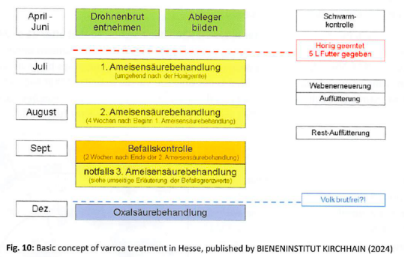
In addition to the use of organic acids, the use of synthetic varroacides with the active ingredients flumethrin or amitraz is possible in exceptional cases. They are only available in pharmacies or even on prescription and are prohibited by the Eco-EU Directive for certified organic beekeeping operations, as they leave residues in the honey and wax. The synthetic agents “usually act as a neurotoxin on the mites and cause them to fall off the bees and eventually die” (BIENENINSTITUT
KIRCHHAIN, Varrozide 2022: 5 ff.).
5.4 Treatment of the Varroa mite with the BICOM® bioresonance method
Even when organic acids are used, they can – if used incorrectly – lead to higher bee mortality. They are also “very likely to affect the honey and can quickly make it inedible. Varroa treatment is therefore only permitted after the last honey harvest of a season, or in clusters etc. from which no more honey is to be harvested in the current season” (BIENENINSTITUT KIRCHHAIN, Varrozide 2022: 1).
In our certified organic family beekeeping business, we have around 40 colonies, and have been working chemical-free for over three years, i.e. without the use of approved organic acids. This is a basic prerequisite for carrying out beehive air therapy, as the air from the beehive should bring people health and not stress.
Now we are expanding our possibilities by starting a small research project on Varroa treatment with the BICOM® bioresonance method. For over a year, we will exclusively use the bioresonance method on four test colonies at separate locations. There are high hopes that the treatment of the bee colonies (up to 60,000 individuals per colony in summer) could not only treat the Varroa mites living in them, but also any other bee diseases at the same time. The following bee diseases are theoretically conceivable, but cannot be discussed further in our project presented below.
Experiments and analyses in this area must be postponed for the time being.

5.4.1 Preliminary tests
Using standard Varroa counts, four bee colonies from one location were selected that had the highest mite loads. The number of dead mites was counted after 7 days using the “Varroa drawer”.

After being moved to their new location, the colonies were placed in groups of two. This ensures that treatment with the bioresonance method can be carried out on two hives at the same time.
The hives are made of natural wood and are coated on the outside with linseed oil as hive protection, which is approved for organic certification. The frames of the brood chamber, which are surrounded by bees, are located directly under the untreated wooden lid, which is less than 1 cm thick. There is therefore only a narrow wooden panel between the modulation mat and the bees, so that the penetration depth of the therapy information is guaranteed.
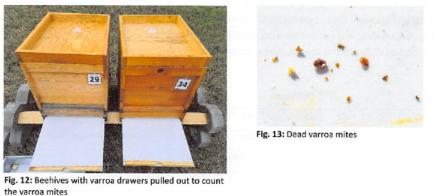
Preliminary tests were carried out at regular intervals, although the operating conditions of the BICOM optima® only allowed this from an ambient temperature of 10°C and above. Nevertheless, we were able to collect data and used the favorable weather conditions to carry out the treatment and to count the natural death of the mites on the (now permanently inserted) Varroa drawers. The treatment set-up was as follows:
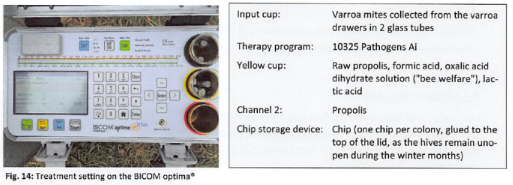
In the previous preliminary tests, the following were evaluated:
1. Number of mites dropped per day. The mite count was carried out directly during the bioresonance treatment.
2. Documentation in the stock card:
a. Level of the bees’ natural death on the grid floor (view into the approach hole)
b. Presence of the queen bee in the colony (tapping test, stethoscope)
As can be seen in the graph below, the number of mites decreased over the weeks. This is natural in a healthy colony, as the brood nests become smaller and the Varroa mites have no opportunity to multiply. As already mentioned, in the best case a brood break occurs. Irrespective of this, the count should not exceed one mite per day in mid/end December.
With the exception of colony 27 – the colony with the highest level of stress at the beginning – this was also the case. Further statements are not possible for this period due to the season.
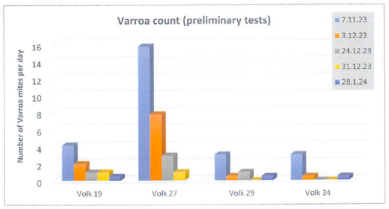
5.4.2 Test arrangement and schedule
The weeks leading up to the submission of the lecture script served as preliminary tests. From spring 2024, when the bee colonies have resumed their flight operations and the colony strength increases due to larger brood nests, we will begin the actual data collection of the Varroa project.
Only now does it make sense, as the increase in bee offspring also gives the Varroa mite the opportunity to occupy more brood combs. A break in brood during a frost period does not give the mites a chance to multiply. Winters with prolonged temperatures below 0°C are bad for the Varroa mite, but good for the survival of the bee colony. For this reason, an artificial interruption of the brood in the summer months is an effective means of inhibiting the mite population at the peak of its development. However, this possibility cannot be discussed further here.
Four reference colonies are documented as controls for the study period. They are located at a different site and are treated against Varroa infestation with hyperthermia (Varroa controller) that we use as standard. The control colonies are also located in RoRbach. They are therefore exposed to the same Varroa pressure as the test colonies. This would not be the case at our locations in Halle (Saale)
due to the large city. Here the Varroa load is much higher and therefore there are no comparable environmental conditions.
As the hives were not opened in the winter months so as not to stress the bees and force them to fly up (risk of clamming in cold temperatures), the first inspections can only be carried out in the warm spring days from March. If, contrary to expectations, a bee colony in the test series has died by this time, it can still be replaced by a new one. After the hyperthermic spring treatment of the remaining colony, this is no longer possible for reasons of comparability between the experimental and control colonies.
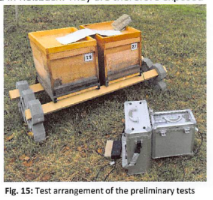
The inspection of the bee colonies allows further examination parameters and possible uses of applicators, which can now be placed specifically on the brood nests (see overview below).
Naturally, there are a large number of nurse bees here. In this way, the mites in the capped brood combs and those sitting on the bees can be recorded.
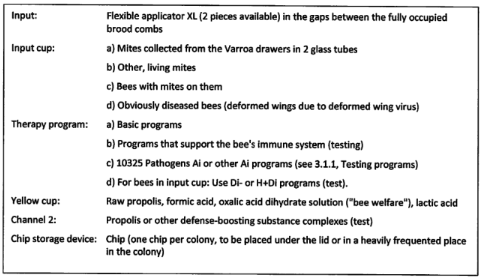
At the start of the field trials, the treatment parameters that are then set are maintained throughout the year (reproducibility). A treatment including a mite count is carried out every 4 weeks. The 4-week interval was chosen because the lifespan of a Varroa mite is around 2 to 3 months in summer and 6 to 8 months in winter. The practical implementation for future users was also taken into consideration. On the same day, the mite count is carried out in the reference colony, which is treated according to the previous annual Varroa concept (hyperthermia).
5.4.3 Objective
The aim of the one-year research project is to investigate whether the BICOM® bioresonance method can be used to reduce the Varroa load in colonies of the western honey bee Apis mellifera. The aim is to develop a standardized, reproducible treatment concept that is easy for BICOM® therapists to implement as a real alternative to conventional Varroa control and to keep our bee colonies healthy.
6 Closing
I hope that my contribution to has provided much new knowledge and good possibilities in the treatment of mites and the diseases caused and transmitted by them. | wish all BICOM® bioresonance therapists every success!
7 Literature
7.1 Publications
AKADEMIE FUR KOMPLEMENTAR- UND INFORMATIONSMEDIZIN: BICOM® Bioresonance Method. Tips for therapists, Academy for Complementary and Information Medicine, Malchow (2022).
BIENENINSTITUT KIRCHHAIN: Varrocides, Landesbetrieb Landwirtschaft Hessen, Bieneninstitut Kirchhain (2022)
BOECKING, OTTO: Varroasis a brood disease of the honey bee, Niedersichsisches Landesinstitut fiir Bienenkunde Celle (2002).
CORNELISSEN, G.: Zusétzliche Beobachtungen zur Allergie-Therapie ohne Allergen-Karenz, Colloquium der Bioresonanz-Therapie-Gesellschaft vom 12.-14.6.1992 in Erding, RTI-Heft 10, Institut fir Regulative Medizin, Gréfelfing (1992).
DECHER, BETTINA: The mold – invisible under the tip of the iceberg “Allergy”, 53rd International BICOM® Congress, May 3-5, 2013 in Fulda, RTI-Heft 37 – May 2013, REGUMED GmbH Ausbildungsinstitut Grafelfing (2013).
DONZE, GERARD, FLURI, PETER and ANTON IMDORF: Highly organized life in a small space: The reproduction of Varroa mites in the capped brood cells of bee colonies, Swiss Centre for Bee Research (1998).
ENGEHAUSEN, ROVENA: Allergy or intolerances in dogs – a therapy scheme for practice, Autumn Congress Online Veterinary Medicine of the Academy for Complementary and Information Medicine, issue AKI No. 2, Malchow (2022).
HARTE, ASTRID: Auch Tiere kénnen nicht aus ihrer Haut – Hauterkrankungen im VET-Bereich, 49th International Congress for BICOM® Users, 1.5.-3.5.2009 in Fulda, RTI-Heft 33, REGUMED Institut fiir Regulative Medizin, Gréfelfing (2009).
HENNECKE, JURGEN: Zwei Jahre Erfahrungen mit der Allergie-Therapie ohne Karenz – Auswertung einer statistischen Studie, praktische Konsequenzen, Colloquium des Internationalen Medizini- schen Arbeitskreises BICOM® Therapie vom 1.-3.10.1993 in Fulda, RTI-Heft 13 – Méarz 1996, Institut fiir Regulative Medizin, Gréfelfing (1996).
HENNECKE, JURGEN and SIMONE MAQUINAY-HENNECKE: Praxisorientierte Therapiesystematik und effektive Allergietherapie, Seminarskript 2023, Akademie fiir Komplementir- und Informationsmedizin (2023).
HINTERSEHER, CHRISTOPH: VET online consultation, tick and ectoparasites, handout with treatment suggestions, Academy for Complementary and Information Medicine (2022).
JANSEN, BETTINA: Effektive Allergiebehandlung mit Testampullen in Kombination mit Nativproben, Colloquium der BICOM® Bioresonanz-Therapie-Gesellschaft 3.-5.5.1996 in Fulda, RTI-Heft 18 – Mai 1996, Institut fiir Regulative Medizin, Grifelfing (1996).
JUNG, W. and JIN, L.S.: Klinische Studie der Therapie von allergischem Asthma und allergischer Rhini- tis mit dem BICOM® 2000, 46. Internationaler Kongress fiir BICOM® Anwender, 28.4.-30.4.2006 in Fulda, RTI-Heft 30, REGUMED Institut fiir Regulative Medizin, Gréfelfing (2006).
KAJASI, ALl Einsatz der Bioresonanz-Therapie in der Augenheilkunde, Internationaler Kongress fiir BICOM® Anwender, 29.1.-1.5.2005 in Fulda, REGUMED Institut fiir Regulative Medizin, Gréfelfing, RTI-Heft 29 (2005).
MULLER, GEORG: “Zwischenzehenekzeme” bei Pferden, 51st International Congress for BICOM® Users, 3.6.-5.6.2011, RTI-Heft 35, REGUMED Ausbildungsinstitut Gréfelfing (2011).
RADTKE, JENS: Influence of brood removal in the honey bee Apis mellifera on the performance of colonies and their parasitization with Varroa destructor, dissertation Martin Luther University Halle-Wittenberg (2010).
RAHADIAN, LINDA: In vitro study on house dust mite allergy, International Medical Working Group BICOM® Bioresonance Method, RTl issue 43 (2019).
RAUCH, SABINE: Mdglichkeiten in Privention und Therapie von akuten Viruserkrankungen, 2nd Online Congress of the International Medical Working Group BICOM® Bioresonance Method for BICOM® Users, RTI-Heft 45, Planegg (2021).
REGUMED GMBH: Final report clinical study. Proven effectiveness in the treatment of allergies using the BICOM® bioresonance method, Flyer REGUMED GmbH, Planegg (2022).
ROSENKRANZ, PETER, AUMEIER, PIA and BETTINA ZIEGELMANN: Biology and control of Varroa destructor, in: Journal of Invertebrate Pathology, Vol 103, pp. 96-119 (2010).
SCHUHMACHER, PETER: Biophysical diagnosis and therapy of allergies. New ways to counter a widespread disease with bioresonance, new edition, Book on Demand, Norderstedt (2012).
SCHUHMACHER, PETER: Die Testsdtze nach Dr. P. Schuhmacher, 8th unchanged edition, Eigenverlag (2013).
SIGRBERG, KARIN: The role of early and repeated vaccinations in the development of chronic and/or gastrointestinal complaints in young dogs, Autumn Congress Online Veterinary Medicine of the Academy for Complementary and Information Medicine, AKI No. 2, Malchow (2022).
WAGNER, MICHAEL: Outstanding successes in the treatment of restless legs syndrome, 55th International BICOM® Congress, 1.5.-3.5.2015 in Fulda, RTI-Heft 36, REGUMED GmbH Ausbildungsinstitut, Gréfelfing (2012).
WENZEL, EBERHARD: Bioresonance in ENT practice: Removing polyps without surgery? 52nd International Congress for BICOM® Users, 28.4.-30.4.2012 in Fulda, RTI-Heft 36, REGUMED GmbH Ausbildungsinstitut, Gréfelfing (2012).
WILDFORSTER, ANDREAS: Allergies. Do | really have to live with them? Recommendations for a symptom-free everyday life, tedition GmbH (ed.) (2023).
WIMMER, WOLFGANG: Praxishandbuch der thermischen Varroa-Bekdmpfung, 3rd edition, ECODESIGN company engineering & management consultancy GmbH, Vienna (2021).
7.2 Internet sources
https://www.allergieinformationsdienst.de/krankheitsbilder (04.01.2024).
https://allesuebermilben.de (03.02.2024).
https://www.bienenschade.de/ (11.02.2024).
https://www.blv.admin.ch/blv/de/home/tiere/tierseuchen/uebersicht-seuchen/alle-ti-erseuchen/tracheenmilben-krankheit-acarapis-woodi-.html, Federal Food Safety and Veterinary Office FSVO (11.02.2024).
https://www.hno-aerzte-im-netz.de/krankheiten/nasennebenhoehlenentzuendung-chronische/ursachen-und-risiken.html (04.01.2024).
https://frontline.de/milben/ (06.02.2024).
https://www.geo.de/geolino/tierlexikon/19625-rtkl-spinnentiere-milben (26.01.2024).
https://www.fli.de/de/aktuelles/tierseuchengeschehen/bienenkrankheiten/, Friedrich-Loffler- Institut (11.02.2024).
https://gesund.bund.de/hausstauballergie (04.01.2023)
https://llh.hessen.de/bildung/bieneninstitut-kirchhain/beratung-und-dienstleistungen/info-und-arbeitsblaetter/03-krankheiten-seuchenrecht-vergiftungen/, worksheet 319a, basic concept of varroa treatment (11.02.2024).
https://llh.hessen.de/bildung/bieneninstitut-kirchhain/beratung-und-dienstleistungen/info-undarbeitsblaetter/03-krankheiten-seuchenrecht-vergiftungen/, Worksheet 324, Viruses of bees (11.02.2024).
http://www.imkerpate.de/bienenkrankheiten/ (11.02.2024)
https://www.pestium.de/bettwanzen-stiche-und-juckreiz/kleine-milben/nasenmilben
(29.01.2024).
https://www.regumed.shop/Produkte/ (10.02.2024).
https://www.softsan.de/ratgeber/milben (26.01.24).
https://www.spektrum.de/lexikon/biologie/milben/43037 (03.02.2024).
https://tierarzt-karlsruhe-durlach.de/cheyletiellose-pelzmilbeninfektion-bei-haustieren/ (06.02.2024).
https://www.umweltbundesamt.de/mehimilbe (06.02.2024).
7.3 lllustration credits
Fig. 1. WALKER, ALAN R.: Mite larva with its formed food canal (stylostome), in: https://com-mons.wikimedia.org/wiki/File: Trombicula-mite-larva-with_stylostome-2.jpg#/media/ File: Trombicula-mite-larva-with_stylostome-2.jpg (04.02.2024).
Fig. 2. KALUMET: Scavenger mite, female, in: https://commons.wikimedia.org/wiki/File:Sarcoptes_scabei_2.jpg#/media/File:Sarcoptes_scabei_2.jpg (04.02.2024).
Fig. 3. KALUMET: Demodex canis (250 to 300 um long), https://commons.wikimedia.org/wiki/File: Demodex_Mite_adult.jpg#/media/File:Demodex_Mite_adult.jpg (04.02.2024).
Fig. 4: The dog’s nasal mite, seen from the back and belly, in: https://www.pes-
tium.de/bettwanzen-stiche-und-juckreiz/kleine-milben/nasenmilben/ (05.02.2024).
Fig. 5 MiLLs, JOEL MILLS, JOEL: Photograph of an ear mite (Otodectes cyanotis) taken with 100x magnification through a microscope, in: https://commons.wiki-
media.org/wiki/File:Ear_mite_1.JPG#/media /File:Ear_mite_1.JPG (04.02.2024).
Fig. 6. Scientific illustration of a house dust mite, in: https://www.shutterstock.com/
imageillustration/scientific-illustration-common-dust-mite-305275442 (05.02.2024).
Fig. 7 Apis mellifera, photo: DENIS PFISTER-GRUNE (22.04.2023).
Fig. 8 Joint development of bee and mite, in WiIMMER, WOLFGANG Praxishandbuch der thermischen Varroa-Bekdmpfung, 3rd edition, CODESIGN company engineering &management consultancy GmbH, Vienna (2021) and used there from: Bieneninstitut Kirchhain: Brood development of Apis and Varroa, worksheet 310 (2012).
Fig. 9: Male and female Varroa mites in different stages of development, in Wimmer, Wolfgang: Praxishandbuch der thermischen Varroa-Bekémpfung, 3rd edition, CODESIGN company engineering &management consultancy GmbH, Vienna (2021). Quoted here from: ROSENKRANZ, PETER, AUMEIER, PIA and BETTINA ZIEGELMANN: Biology and control of Varroa destructor, in: Journal of
Invertebrate Pathology, Vol 103, pp. 96-119 (2010).
Fig. 10. basic concept of varroa treatment Hesse, https://llh.hessen.de/bildung/bieneninstitutkirchhain/beratung-und-dienstleistungen/info-und-arbeitsblaetter/03-krankheiten-seuchenrechtvergiftungen/, worksheet 3193, basic concept of varroa treatment (11.02.2024).
Fig. 11: Beehives during treatment, photo: DENIS PFISTER-GRUNE (24.12.2023).
Fig. 12: Beehives with Varroa drawers pulled out to count the Varroa mites, photo: DENIS PFISTERGRUNE (24.12.2023).
Fig. 13: Dead mites collect on the floor scraper, in: https://llh.hessen.de/bildung/bieneninstitutkirchhain/beratung-und-dienstleistungen/info-und-arbeitsblaetter/03-krankheiten-seuchenrecht–vergiftungen/, worksheet 341, (11.02.2024).
Fig. 14. treatment setting on the BICOM optima®, photo: DENIS PFISTER-GRUNE (24.12.2023).
Fig. 15. test arrangement of the preliminary tests, photo: DENIS PFISTER-GRUNE (24.12.2023).
